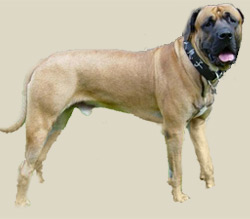
Country of Origin: Japan
Group: Pinscher and Schnauzer - Molossoid Breeds - Swiss Mountain and Cattle Dogs
Section: Molossoid breeds
Original Function: dog fighting
Todays Function: guard, companion
Dimension Male: 55-75 cm
Dimension Female: 55-75 cm
Weight Male: 54-77 kg
Weight Female: 40-55 kg
Litter Size: 6-12 puppies
Life span: 10-12 years
Other Names: Japanese Fighting Dog, Japanese Mastiff, Japanese
Colors: Tan with or without markings in a different shade of tan, or tan markings on white. they can also be
Living: The tosa inu will do better with a dog-experienced person. this is likely a person who is firm and d
Recognized: CKC, FCI, NKC, APRI, ACR
Description
The Tosa, also called the Tosa-Inu or Tosa-Ken, is a stately, massive dog. Athletic and surprisingly agile. The head is large, with a broad skull, fairly abrupt stop, and a moderately long, squared-off muzzle. The jaws are very powerful. The skin at the neck forms a dewlap. The ears are fairly small and pendant, falling along the cheeks. The eyes are small, dark and almond-shaped, with a dignified expression. The long tail is very thick at the root then tapers to a point, reaching the hocks. The short-haired coat is dense and harsh. The preferred color is solid red, though black, yellow, black & tan, fawn, brindle and multi-colored is also permissible.
Temperament
Tosa Kens are quiet and reserved inside the home. They are affectionate and friendly with family. They are more aloof with strangers, however, and can be used as an excellent guard dog. They can be dog aggressive, however. They are devoted to their family. Tosas are trainable, excellent fighters, agile and athletic. They are well behaved at home and a protective companion. They are happy to greet friends and family, but suspicious of strangers. They do not like being left alone, and should not be left in a kennel. They bark only when necessary, and are brave and intelligent. The Tosa are also a patient breed.
Excercise
The Tosa Inu does not require a lot of exercise, only an average amount. If given a yard and a place to roam, they will get all the exercise they need.
Grooming
The Tosa is easy to groom. An occasional brushing to remove dead and loose hair is all that is needed to keep the coat looking good. The Tosa may not drool as bad as other mastiffs but, they do drool, especially when they get excited, hot or when they dri
Health
Major concerns: CHD, gastric torsion
Minor concerns: patellar luxation, elbow dysplasia,
Occasionally seen: PRA
Suggested tests: knee, eye

